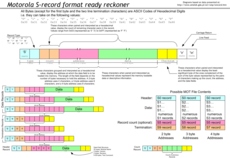SREC (file format)

A quick reference chart for the Motorola SREC format.
|
|
| Filename extension | .s19, .s28, .s37, .s, .s1, .s2, .s3, .sx, .srec, .mot |
|---|---|
Motorola S-record is a file format, created by Motorola, that conveys binary information in ASCII hex text form. This file format may also be known as SRECORD, SREC, S19, S28, S37. It is commonly used for programming flash memory in microcontrollers, EPROMs, EEPROMs, and other types of programmable logic devices. In a typical application, a compiler or assembler converts a program's source code (such as C or assembly language) to machine code and outputs it into a HEX file. The HEX file is then imported by a programmer to "burn" the machine code into non-volatile memory, or is transferred to the target system for loading and execution.
The S-record format was created in the mid-1970s for the Motorola 6800 processor. Software development tools for that and other embedded processors would make executable code and data in the S-record format. PROM programmers would then read the S-record format and "burn" the data into the PROMs or EPROMs used in the embedded system.
There are other ASCII encoding with a similar purpose. BPNF, BHLF, and B10F were early binary formats, but they are neither compact nor flexible. Hexadecimal formats are more compact because they represent 4 bits rather than 1 bit per character. Many, such as S-record, are more flexible because they include address information so they can specify just a portion of a PROM. Intel HEX format was often used with Intel processors. Tek Hex is another hex format that can include a symbol table for debugging.
An SREC format file consists of a series of ASCII text records. The records have the following structure from left to right:
SREC records are separated by one or more ASCII line termination characters so that each record appears alone on a text line. This enhances legibility by visually delimiting the records and it also provides padding between records that can be used to improve machine parsing efficiency.
Programs that create HEX records typically use line termination characters that conform to the conventions of their operating systems. For example, Linux programs use a single LF (line feed, hex value 0A) character to terminate lines, whereas Windows programs use a CR (carriage return, hex value 0D) followed by a LF.
...
Wikipedia
